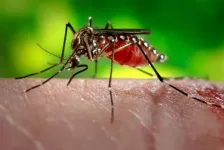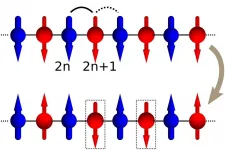New drug molecules hold promise for treating fatal child disease
2021-02-22
(Press-News.org) Scientists have identified a way to "rescue" muscle cells that have genetically mutated, paving the way to a possible new treatment for rare childhood illness such as Duchenne Muscular Dystrophy (DMD).
The study, led by the Universities of Exeter and Nottingham, is published in the Proceedings of the National Academies of Sciences, USA. The research used novel drugs being developed at the University of Exeter, which "metabolically reprogram" the cellular energy production centres in muscle cells, by providing them with a fuel source to generate metabolic energy.
DMD is a genetic condition caused by a mutation in a gene called dystrophin which results in progressive irreversible muscular degeneration and weakening. Its symptoms include muscle atrophy leading to a loss of the ability to walk in children for which there is no known cure. Currently, the condition is treated with steroids, such as prednisone, but they can stop working and side-effects are common. The research, funded by the Medical Research Council (UK) and United Mitochondrial Disease Foundation in the USA, was led by Professors Nate Szewczyk in Nottingham and Matt Whiteman in Exeter focussed on future alternative ways to improve muscle performance when the dystrophin gene is missing or is defective.
The research team comprising of scientists from Australia, USA, The Netherlands and Germany as well as the UK first used microscopic worms (C. elegans) and then mice with specific genetic mutations affecting muscle strength, that match mutations that cause DMD in humans. The team found that these animals had defects in gait, movement, and muscle strength, and had marked defects in the structure their muscle mitochondria, the tiny organelle responsible for cellular energy regulation.
The animals also had lower levels metabolic enzymes used for the generation of the gasotransmitter hydrogen sulfide in their muscles, as well as lower levels of the gas itself. Treating these animals with a compound called NaGYY, which replaced the lost hydrogen sulfide, partially reversed some of the muscle and mitochondrial defects in the same way the standard of care drug prednisone did. However, specifically targeting mitochondria with hydrogen sulfide using the compound AP39, exhibited the same effects but at 3.7 million fold lower dose.
Professor Nate Szewczyk of the Ohio Musculoskeletal & Neurological Institute, USA commented "Steroids are very effective and safe drugs but their use over a long period of time causes effects wear off and they can have some very unpleasant and life-changing side effects. The compounds we've used in our study are not steroids and they work in a very similar way to these drugs give the same improvement in muscle function, but at a much, much lower dose and because they are not steroids, they are unlikely to produce steroid-induced side effects such as weaker muscle and decreased ability to fight infection".
PhD student Rebecca Ellwood added "Life first emerged on earth in a sulfide rich environment and thrived for billions of years before it was replaced by the oxygen we have today. Our cells and our mitochondria have maintained the ability to both make and use very small amounts of sulfide to keep healthy. Our study now shows that in DMD models, this metabolic pathway is defective, offering a potential for therapeutic intervention to correct this defect".
Professor Matt Whiteman, of the University of Exeter Medical School, who developed the tool compounds used in this study, and next generation molecules for commercialisation, said,: "We're really excited that our findings show that a deficit in muscle sulfide may contribute to the development of Duchenne Muscular Dystrophy. Rectifying this deficit may lead to new treatment approaches for this and other currently incurable diseases, without relying on potentially harmful steroids. At Exeter we are developing more advanced approaches to target muscle mitochondria, and we aim to spin-out a new biotech company called 'MitoRx Therapeutics' to develop these newer approaches for clinical use during 2021."
Dr Kate Adcock, Director of Research and Innovation at the charity Muscular Dystrophy UK, said: "We welcome research that increases our understanding of molecular pathways that could both contribute to the symptoms of Duchenne muscular dystrophy and offer potential new therapeutic targets. Although a long way from patient studies, this research has shown interesting results in animal models of Duchenne muscular dystrophy and it is encouraging to see these early stage studies for such a complex, rare condition."
INFORMATION:
Full name of paper -- Mitochondrial hydrogen sulfide supplementation improves health in the C. elegans Duchenne muscular dystrophy model
Notes to editors: About the University of Exeter Medical School
The University of Exeter Medical School is part of the University of Exeter's College of Medicine and Health. Our mission is to improve the health of the South West and beyond, through the development of high quality graduates and world-leading research that has international impact.
As part of a Russell Group university, we combine this world-class research with very high levels of student satisfaction. Exeter has over 19,000 students and is ranked 12th in The Times and Sunday Times Good University Guide 2020.
The University of Exeter Medical School's Medicine course is in the top 10 in the Complete University Guide 2020.
The College's Medical Imaging programme is ranked in the top 5 in the Guardian Guide 2020 and the Complete University Guide 2020.
The University of Exeter entered the world top 20 for Biomedical and Health Sciences in the CWTS Leiden Ranking 2019, based on the percentage of publications ranked in the top 10 per cent most cited.
https://medicine.exeter.ac.uk/
For further information:
Louise Vennells
Press and Media Manager
University of Exeter Medical School
+44 (0)1392 724927 or 07768 511866
l.vennells@exeter.ac.uk
About MitoRx
At MitoRx our mission is to become the leading global developer of medicines alleviating the suffering caused by diseases involving mitochondrial dysfunction. We are a preclinical research stage rare disease platform biotech developing our lead program MTRX-1 as a first-in-class first-in-target mitochondrial protective therapeutic initially targeting rare neuromuscular disorders (NMD) including Duchenne, as well as rare metabolic disease and neurodegenerative disease. MitoRx targets diseases of mitochondrial dysfunction where the trans-sulfuration pathway is disturbed, which generates endogenous hydrogen sulfide. MitoRx restores levels of this endogenous signalling molecule within mitochondria, providing the substrate required to activate a conserved response to resist mitochondrial oxidative stress, in a novel mitochondrial protective strategy.
http://www.mitorxtherapeutics.com
Press Contact (MitoRx)
Jon Rees, CEO
jon.rees@jonreesassociates.com
Tel. +44 7826 556622
Important Note
The compounds described in this press release are experimental and have not yet been tested in clinical trials, nor are they approved for medical treatment.
ELSE PRESS RELEASES FROM THIS DATE:
2021-02-22
Things just got hairy at Princeton.
Researchers found they could coat a liquid elastic on the outside of a disc and spin it to form useful, complex patterns. When spun just right, tiny spindles rise from the material as it cures. The spindles grow as the disc accelerates, forming a soft solid that resembles hairs.
Inspired by biological designs and rationalized with mathematical precision, the new method could be used at an industrial scale for production with plastics, glasses, metals and smart materials.
The researchers published their findings ...
2021-02-22
(Boston)--Tau is a protein that helps stabilize the internal skeleton of nerve cells (neurons) in the brain. Groups of toxic tau protein, termed tau oligomers, drive disease progression and memory loss in Alzheimer's disease (AD). A new study from Boston University School of Medicine (BUSM) shows how these tau oligomers form, and, correspondingly, how they can be prevented.
AD is a major cause of disease in the elderly and places a huge financial cost on the health care system. Scientists have known for a long time that two proteins (?-amyloid and tau) clump and accumulate in the brains ...
2021-02-22
LOGAN, UTAH, USA -- You might not like mosquitoes, but they like you, says Utah State University biologist Norah Saarman. And where you lead, they will follow.
In addition to annoying bites and buzzing, some mosquitoes carry harmful diseases. Aedes aegypti, the so-called Yellow Fever mosquito and the subject of a recent study by Saarman and colleagues, is the primary vector for transmission of viruses causing dengue fever, chikungunya and Zika, as well as yellow fever, in humans.
"Aedes aegypti is an invasive species to North America that's become widespread in the eastern United States," says Saarman, assistant professor in USU's Department of Biology and the USU Ecology Center, whose research focuses ...
2021-02-22
Adolescents and teens may be more likely to be bullied by their friends -- and friends-of-friends -- than classmates they don't know as well, according to a new study.
Diane Felmlee, Distinguished Professor of Sociology and Demography at Penn State and researcher on the paper, said the findings give new insight into how and why bullying occurs -- important information for anti-bullying efforts.
"People often assume that bullying occurs between relative strangers, or that it targets those on the fringes of the social network," Felmlee said. "Those do occur, but in our study, we find that the rate of peer aggression is significantly higher between those students who are closely linked. Furthermore, our finding is not due to friends simply spending ...
2021-02-22
In a new study out of University of California San Diego School of Medicine, researchers have identified a universal strain of bacteria derived from healthy human skin that can treat the most common type of eczema, also known as atopic dermatitis.
In the paper published Feb. 22, 2021, in Nature Medicine, the research team investigated the safety and mechanisms of this certain bacteria in a first-in-human, Phase I, double-blinded clinical trial looking to treat people living with eczema. Of the 54 participants, two-thirds reported improvements in their ...
2021-02-22
The diversity and numbers of wild salmon in Northern B.C. have declined approximately 70 per cent over the past century, according to a new Simon Fraser University study.
Researchers drawing on 100-year-old salmon scales report that recent numbers of wild adult sockeye salmon returning to the Skeena River are 70 per cent lower than 100 years ago. Wild salmon diversity in the Skeena watershed has similarly declined by 70 per cent over the last century.
The research undertaken by Simon Fraser University (SFU) and Fisheries and Oceans Canada was published today in the Journal of Applied Ecology.
The research team applied modern genetic tools to salmon scales collected from commercial ...
2021-02-22
Boston, Mass. - Even with more than 1.5 million Americans receiving a COVID vaccine each day, officials estimate it will take many more months before enough people are protected from the deadly virus. Until then, and potentially beyond, experts agree that opening up schools, restaurants and other public places as safely as possible will rely on widespread testing for SARS-CoV-2, the virus that causes COVID-19.
As of June 2020, the U.S. Food and Drug Administration (FDA) had granted emergency use authorization for more than 85 different viral DNA test kits -- or assays -- each with widely varying degrees of sensitivity and unknown rates of accuracy. However, with no existing gold standard test for the novel coronavirus, there's little data on which ...
2021-02-22
A paper recently published in the scientific journal Stem Cells and Development shares an important advancement in conservation -- one that may make the difference between survival and extinction for wildlife species that have been reduced to very small population sizes. Using fibroblast cells that have been preserved in San Diego Zoo Global's Frozen Zoo®, scientists have been able to generate induced pluripotent stem cells of northern and southern white rhinoceroses. This important breakthrough is the first step in a complex process for generating gametes from deceased and non-reproductive individuals of these two subspecies.
"For the northern white rhino, which is functionally extinct, the only hope for survival may be in the ...
2021-02-22
ITHACA, N.Y. - Cornell University scientists have identified a new contender when it comes to quantum materials for computing and low-temperature electronics.
Using nitride-based materials, the researchers created a material structure that simultaneously exhibits superconductivity - in which electrical resistance vanishes completely - and the quantum Hall effect, which produces resistance with extreme precision when a magnetic field is applied.
"This is a beautiful marriage of the two things we know, at the microscale, that give electrons the most startling ...
2021-02-22
LOS ALAMOS, N.M., Feb. 22, 2021--A team of quantum theorists seeking to cure a basic problem with quantum annealing computers--they have to run at a relatively slow pace to operate properly--found something intriguing instead. While probing how quantum annealers perform when operated faster than desired, the team unexpectedly discovered a new effect that may account for the imbalanced distribution of matter and antimatter in the universe and a novel approach to separating isotopes.
"Although our discovery did not the cure the annealing time restriction, it brought a class of new physics problems that can now be studied with quantum annealers without requiring they be too slow," said Nikolai Sinitsyn, a theoretical physicist at Los Alamos National ...
LAST 30 PRESS RELEASES:
[Press-News.org] New drug molecules hold promise for treating fatal child disease


